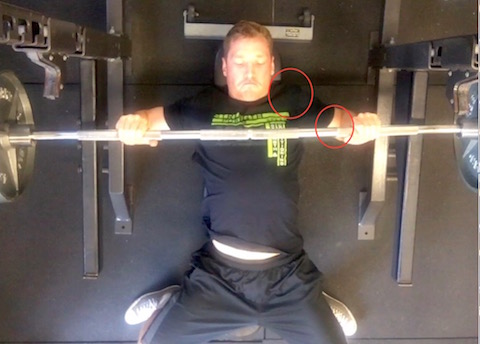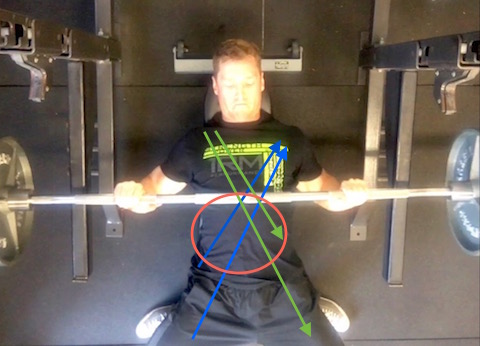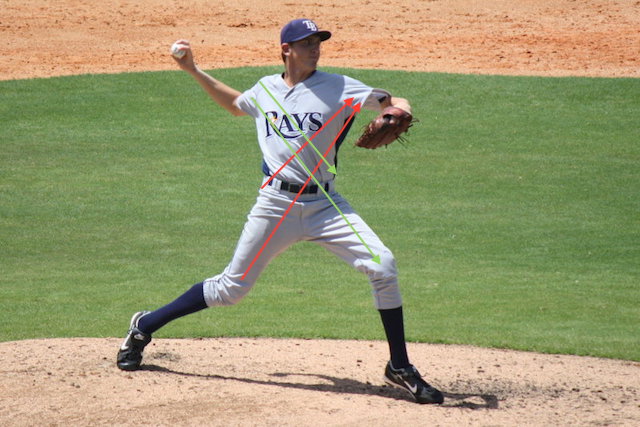Should Baseball Players Bench?
The classic question of whether or not baseball players should bench; I hear this question at least twice a week. My answer: yes and no. The answer is neither yes or no because there are a lot of people in this world (baseball, overhead athlete, non sport athletes…) that honestly shouldn’t bench. Why? because they don’t know to bench PROPERLY. I will go out on a limb and say anyone that doesn’t know how to bench shouldn’t bench, and anyone that knows how to bench properly should. Follow along as I lay to rest all the claims made against baseball players and benching. 
The 4 most common reasons I hear that baseball players shouldn’t bench are:
1. It’s bad for their shoulders.
2. Their pecs will be too developed and baseball players shouldn’t have big pecs.
3. They need to spend more time working on their rotator cuff and decelerators. “You can only accelerate as fast as you can decelerate.”
4. Benching isn't sport specific so it doesn’t help increase throwing velocity.
Now, let’s just get right into it. I said this before and I’ll say it again, if you don’t know how to bench, or you think you do, but it causes you pain, stop benching. If you know how to bench, and have no pain, keep benching. It is that simple! Just make sure you do your pulling exercises to maintain balance.
When it comes to benching there are endless variations that have the potential to be of benefit to a baseball players and other overhead athletes. Each variation has slghtly different demands on your Glenohumeral Joint and rest of your body. I would say it is most difficult to coach an athlete, especially with underlying movement issues within their shoulders, how to bench properly with a barbell. To make your life easier you can use dumbbells, kettlebells, single arm db presses on the bench, single arm presses on the floor, you can bench with a bamboo bar to force your athlete to create stability, and you can do my new favorite Mckenzie presses which really get an athlete to fire up the oblique sling and create stability. But it is important to remember that cueing is still extremely similar. The pressing possibilities are endless. And what works for one won’t always work for others.
A quick example here is one of our athletes Sydney Poh. Poh as we call her, can’t bench with a barbell at school because it hurts her shoulders. However, at 1RM Performance we have her doing single arm DB work, and guess what, she is pain free. The work that she has done with dumbbell pressing, on top of other exercises, has allowed her to play softball again, after dislocating her shoulders three times. Be creative and open-minded. Don’t try and fit a square peg in a round hole!
With that being said, here are the four common reasons baseball players “shouldn’t” bench.
1. Baseball players shouldn’t bench because benching can hurt your shoulders.
Yes, I agree 100%, only if the person doesn’t know how to bench. This goes for any bench variation. Yes, it is easier to have poor mechanics on a barbell bench press, but if you have terrible joint positioning in any dumbbell pressing movement it will still hurt. Now, if a baseball player benches with great mechanics and with ideal joint positioning, regardless of bench variation then go ahead and bench.


The kicker is benching with ideal joint positioning. Don’t let your athletes bench with internal rotation of their shoulders. Remember it’s an internally rotated position that greatly increases your risk of shoulder and elbow issues to begin with. If we train with excessive internal rotation, we over develop strength in internal rotation, and ultimately find ourselves hanging out in internal rotation in everything we do, whether it’s benching, squatting, throwing, etc. This overdevelopment and poor position will wreak havoc on your shoulder. It will change the resting length of internal/external rotators and accelerators/decelerators. It will also change your posture and create an environment within your body that strips you of velocity, ultimately increasing your chance of injury.
To avoid the waterfall of damage associated with benching POORLY, just make sure you or your baseball players know how to bench PROPERLY. You would be surprised what actually teaching athletes how to bench can do for them. A safe bench press means keeping their shoulders centrated. A centrated position on the bench looks like this.
Here are some quick cues to help...
Shoulders should be away from the ears in a slightly externally rotated position. Your scaps are centrated and cranked into the bench as if you’re trying to snap matches underneath them. Head is long. The movement is supported with your deep stabilizing system and Intra abdominal pressure with slight extension of your lumbar spine. Your feet are loaded into the ground, knees are centrated following your second toes, and your glutes and lower extremities are firing. Following this will create tension through our body, keep you centrated, and help you recruit within your oblique sling; maintaining and transfering force from the ground to the bar. This allows for healthy shoulders, decreases the risk of injury, and actually allows you to move weight on the bar. Bad bench mechanics prohibits you from lifting heavy - consider it your body’s personal restrictor.
2. Baseball players shouldn’t bench because they shouldn’t have developed pecs.
Now this one gets me a little bit. It seems a little backwards. Last time I checked, your pecs, and specifically your ability to load your oblique sling is essential for throwing. So if there is an exercise that can do this, why aren’t we doing it? Again, if it’s not done properly, don’t do it, but if it is, let’s exploit it and make our athletes more resilient.

If we go over the oblique slings quickly we know, that the oblique sling, in a rotational sport like throwing is first responsible for rotating your pelvis in the supporting (front)arm. Secondly, it is responsible for rotating your thorax in your Phasic (throwing) arm. While this sling is assisting in rotation, our Lats, mid trap, and rhomboids are helping control rotation of the spine.
Our pecs are needed to throw. Developing your pecs, in relation to the rest of your upper body IS beneficial to pitching and throwing athletes. Yes, there is a limit to how strong an athlete really needs to be on the bench, but last time I checked, I haven’t met many baseball players that are close to that limit.
I have spent time thinking about this idea, and I think this idea comes from kids that have overactive pecs and have lost the co-activation relationship between their internal and external rotators. This means, kids are constantly overloading their internal rotators (pecs are included in here). This pattern shows itself in more then just the bench press. Watch most kids to their jaggerbands, and internal external rotation exercises and you’ll see plenty of over recruiting coming from their pecs and internal rotators. If we teach a kid how to bench, we can actually train our RC while benching. Think about how much work your rotator cuff and the other muscles that control force at the shoulder are doing to keep your humeral head centrated. Your ability to stabilize your shoulder doesn’t shut off as you bench properly. It has to work harder.
Thinking back to what we just mentioned in terms of benching properly, if a kid is coordinated enough, he or she could use the bench press to actually help re-write the loading pattern within his internal/external rotators. If not, here comes some DNS to get deeper into the CNS !
3. Baseball players shouldn’t bench, and instead spend more time working on their external rotators and decelerators.
This is CLASSIC reason to not bench. Yes, your ability to decelerate is key for pitching, and is a must in order to stay healthy. However, this doesn’t mean that every waking exercise should be completed with that in mind. I’m a huge fan of getting my athletes to do pulling exercises. The last workout for two of my pro guys involved 100 total pressing movements at the highest possible velocities with 200 band pull aparts. The workout looked like this…1 press, one clap push up, one standing medball throw, one accelerated med ball throw, and 10 band pull aparts, for 25 and 27 sets. 25 and 27 because that is how many sets we were able to get through before the velocity of the bar, as measured by the gymaware, dropped by 10%. During this workout there were two standards that the guys had to met on each set: speed and quality of movement. If either were lost for two sets in a row, the athlete was cut off.

If we think about the pressing movements used during this workout, and really any pressing exercise you might have an athlete do, they are always training their ability to decelerate. It’s not like an athlete can only accelerate. Think about what was happening as a guy rips a bar down to his chest at a high speed. He has to stop the bar, or it’s going to go through his chest. Where does the braking mechanism come from? Trust me it’s not a divine intervention; it’s the athlete pumping the breaks and decelerating the force. Now add load and greater speed, and you can bet your ass that this athlete is improving his ability to decelerate. Now add a second straight rep at high velocities. You get plenty of decelerating and accelerating forces within the athlete's entire upper body while their lower body is rooted to the ground and loading the oblique sling. Granted the angles are not the exact same as throwing, but not many thing we do with our athletes are. I would bet $10,000 that doing an explosive bench, as described above, will give you velocities and forces more closely related to pitching, than internal external rotation exercises ever would.
4. Benching isn't sport specific and doesn’t help improve your throwing velocities.
Six separate studies, with athletes from national to collegiate levels, have shown a significant increase in throwing velocity coinciding with an increase in the bench press. Within the studies, Potteiger et al. showed increases of 3.3 mph, Hermassi et al. found an increase of 11.4 and 13.3 mph within two different groups and two different training volumes, Hoff et al. 7.8 mph, Newton et al. 2.9 mph, and McEvoy et al. a 4% increase in velocity. All found significant difference over the control. And it might be a surprise, but not a single injury occurred.

Personally speaking, I had a few guys in for this past offseason that have never benched before. Day 1, they were only able to bench 190ish. By the time they left for spring training they were benching over 250, with one benching around 270. The results of this were pretty simple. They were throwing harder earlier in the season, with less effort. Oh and their chests weren’t massive and they're movement wasn't restricted. Granted we weren’t only benching, there was a lot of movement work, lower body training and med ball work (the slam of the ball against the wall got significantly louder through the off season), but still, we didn’t shy away from it, and I believe it helped.
Benching has the potential to increase your throwing velocity and science says so!

Conclusion.
In the grand scheme of things, benching has the potential to increase a baseball players throwing velocity, it has ability to improve and train the powerful oblique sling, it has the ability to re-establish ideal movement patterns within athletes, it has the ability to improve the ability to decelerate and accelerate force, has the ability to improve control of your humerus and strengthen your rotator cuff and surrounding musculature. The kicker is to do it right, with centrated positions.
To say the bench press is dangerous for baseball players is like saying a squat is dangerous for baseball players. They both, if not coached properly increase an athlete’s risk of injury. Both can heavily load internal rotation of their shoulders, and their scaps are fixed in one position. However, coaches believe that benching is worse because there is greater load placed on their shoulders. In my years of being a strength coach and training, I’ve had shoulder pain benching but fixed it by taking the time to actually bench properly.
Kids love to bench. No matter what we say, they are going to do it. So either you teach them how to bench properly with you, or they are going to do some sloppy bench work on their own.. KIDS LOVE TO BENCH. You have two options: you can sit on your high horse and say don’t do it, bash it, and say it’s terrible for baseball players, or you can take the time to teach your athletes how to bench properly. You would be surprised with the benefits it can have within your athletes!

